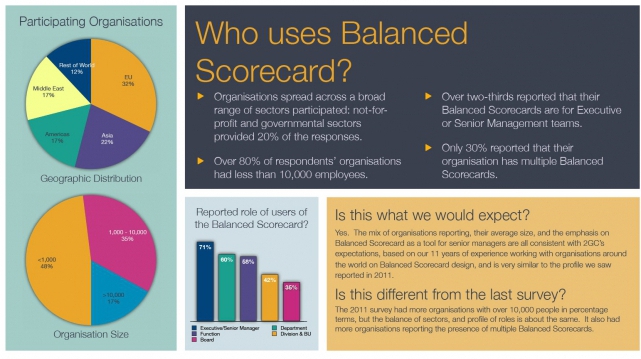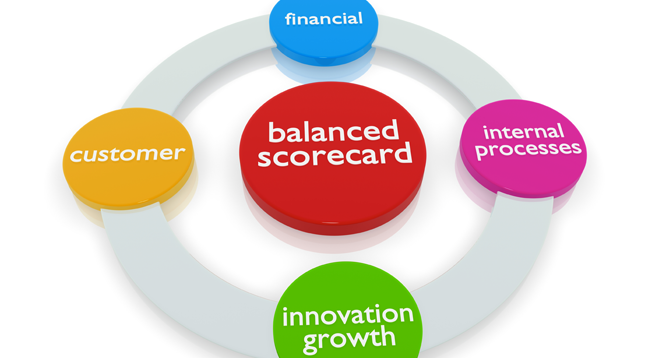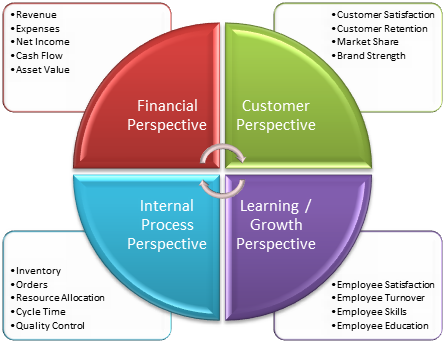The balanced scorecard is a specialized management system with which the company can accurately formulate its plans for the future, develop a strategy and subsequently translate it into reality.
What is this system for?
Using such a system, feedback is achieved between various internal business processes, as well as external indicators, which is required in order to increase strategic efficiency and ultimately achieve appropriate results. When the system of balanced indicators is fully implemented, strategic planning from a standard theoretical exercise turns into one of the most important areas of the enterprise. Thus, the efficiency of the company increases and the stability of its work increases.
What is she like?

According to the developers themselves, the balanced scorecard system provides support for traditional financial indicators, but it’s worthwhile to understand that they reflect only the course of future events, and also provide an adequate description for companies from the time of industrial production, for whom investing in any long-term programs or in improving relationships with consumers was far from as significant as it is today. At the same time, such indicators are absolutely irrelevant when it comes to managing the activities of companies of the time of information technology, which try to achieve future results by investing in the convenience of customers, employees, suppliers, innovations, technologies and a wide variety of business processes.
It is for this reason that a balanced scorecard was proposed, with which it would be possible to supplement the financial indicators with information that would reflect customer satisfaction, internal business processes, as well as the possibility of company development.
What are its features?

This technology provides for the main factors of the company’s work, including customer service, as well as financial and operational efficiency, in the form of a whole set of different characteristics. The company can record and subsequently analyze these characteristics in order to understand whether strategic goals are really achieved in the process. A fully implemented system represents a consistent review of the company's work at each level. Ultimately, each individual employee of the company processes a personal BSC (balanced scorecard), while he tries to achieve his own personal goals. In this case, the employee is based on indicators related to the corporate strategy.
The basics

BSC (balanced scorecard) provides for the consideration of the company from the point of view of four perspectives, as well as the development of quantitative parameters, data collection and their subsequent analysis in accordance with each prospect.
Development and training perspective
This perspective includes the thorough training of specialists, as well as the cultivation of corporate culture, not only on a personal level, but also at the corporate level. In a company where truly educated people work, employees ultimately become the main resource.
In modern conditions, in which there are rapid technological changes, workers engaged in mental work must constantly improve. Government organizations quite often do not have the opportunity to recruit new technically trained employees, and at the same time also reduce the training of existing workers. This is the most important sign of the leak of intellectual power from the company, and it must be stopped without fail in the shortest possible time.
Certain indicators should ultimately fully demonstrate to the management team in which place it will be necessary to concentrate the funds for detailed training of employees so that they bring the maximum possible benefit. In any case, development and training is the main foundation for the success of every truly progressive company.
Business Process Perspective
This perspective, as the name implies, is directly related to internal business processes. From this point of view of the strategy, a balanced scorecard provides managers with the opportunity to determine how efficiently the company works and whether the services and products meet the requirements of potential customers. Such indicators will need to be developed as carefully as possible only to those people who really accurately imagine business processes, that is, even the most professional consultants from outside should not perform such work.
Customer perspective
Balanced system performance indicators in terms of customer perspective, it takes into account the increasing importance of targeting a particular customer, as well as customer satisfaction. The main parameter in this case is that if customers remain unsatisfied, then they will just start looking for other suppliers.
Low efficiency in this direction is a clear sign that the company will face decline in the future, even if at the moment the overall financial picture remains at a consistently high level. In order to develop satisfaction indicators, it will be necessary to carefully analyze the types of processes and customers for which it will be necessary to provide certain types of services and products.
Financial perspective
The people who developed the balanced scorecard system did not deny that traditional financial data could also be used. Providing timely, and at the same time sufficiently clear information will always remain important enough, therefore, managers should try to do as much as possible in order to ensure this.
However, in the overwhelming majority of cases, much more attention is paid to the processing and support of financial data than is really necessary. When implementing a corporate database, a considerable part of the work can and should be not only centralized, but also automated, and you should understand that a special bet on financial indicators leads to an unbalanced situation regarding other prospects. It is for this reason that it may be necessary to take into account additional financial data, including risk assessment and data comparing results and costs.
Measurement-Based Management

The balanced scorecard of the organization is based on key concepts that are developed in previous management practices, such as full quality management, including:
- quality defined by the client;
- continuous improvement;
- empowerment of certain employees;
- most importantly, based on control measurements, as well as the use of feedback.
Dual loop feedback
In the traditional industrial sphere, everything was subject to such concepts as “absence of defects” and “quality control”. In order to ensure truly high efficiency in protecting customers from low-quality products, serious measures will need to be taken related to verification and testing on the production line.

The main problem when using this approach is that the real cause of the marriage can never be detected, while in the process of rejection a certain inefficiency will always remain. In particular, it was noted that at each separate production stage certain minor deviations may appear, the reasons for which will need to be determined and fixed.
If these reasons can be fixed, then in this case there is a way to reduce the number of defective products, and, accordingly, to discover almost unlimited prospects for improving quality. For such progress, they are united by a balanced scorecard, an example of which can be seen in many modern companies, which has a feedback chain.
Why is this needed?
Information will be further worked out by managers in order to determine the causes of deviations of processes in which errors often appear. And after that, appropriate measures are taken to change the set of these processes. In the same way as in the system of full control, the development of a balanced scorecard provides for feedback between various internal business processes and external results. But, in addition to this, it also provides for an additional feedback ring, which combines the results of the business strategies used. Thus, the introduction of a balanced scorecard forms a double-loop feedback ring.
Resulting indicators
It is impossible to fix what cannot be measured, and therefore indicators should be developed based on the priorities of the strategic plan, which contains key factors for business development, as well as criteria for choosing the most interesting characteristics for managers. After that, the process of collecting information that describes these characteristics is carefully designed and they are reduced to a numerical form for storage, display and further analysis.

Persons who in this case make decisions evaluate the final values of several measured processes and strategies, as well as monitor the results in order to achieve proper company management, as well as provide feedback.
Therefore, in this case, the value of the parameters lies in the fact that they represent a basis that determines:
- Strategic feedback that demonstrates to decision makers the current status of the organization in accordance with several perspectives.
- Diagnostic feedback from various processes in order to manage changes.
- Temporal tendencies of change in work efficiency in accordance with the measure of control indicators.
- Feedback between measurement technologies, as well as the choice of controlled parameters.
- Quantitative input parameters for various modeling and forecasting methods that will be used in decision support systems.
Actual management
In this case, the main task of taking measurements is to enable managers to more clearly represent the work of their own company in accordance with several prospects and, accordingly, to achieve wiser and longer-term solutions.

Modern business directly depends on how the processes of measurement and analysis of performance are carried out.Measurements in this case are based on the company’s strategy used and should provide critical information about key processes, output parameters and final results. The information required to evaluate and increase work efficiency can be very different, including information about:
- customers
- the effectiveness of the provision of services or the sale of products;
- the market;
- operations;
- competitive comparisons;
- employees
- suppliers;
- finance and expenses.
The analysis, which includes a balanced system of indicators of Norton and Kaplen, involves the use of information to determine long-term estimates, trends, causes and effects that cannot be determined without its use. Data and analysis are an important tool for achieving a wide range of company goals, including also evaluating results, planning, improving operations, comparing company performance with competing firms or with optimal performance in this area.

